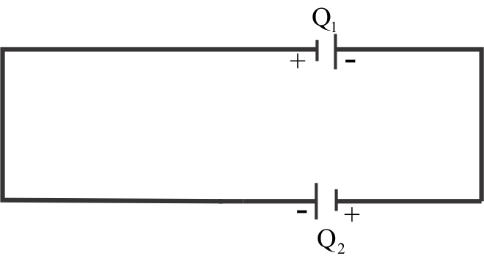
A capacitor is charged by a battery. The battery is removed and another identical uncharged capacitor is connected in parallel. The total electrostatic energy of the resulting system:
$\left( a \right)$ Increase by a factor of $2$
$\left( b \right)$ Increase by a factor of $4$
$\left( c \right)$ Decrease by a factor of $2$
$\left( d \right)$ Remains the same
Answer
221.1k+ views
Hint: Kirchhoff’s Voltage Law is that the second of his elementary laws we will use for circuit analysis. His voltage law states that for a closed-loop system series path the algebraically total of all the voltages around any closed-loop system in an exceeding circuit is adequate zero. This is often as a result of a circuit loop that could be a closed conducting path thus no energy is lost.
Complete step by step solution: Here in the question it is given that the capacitor is charged initially with the battery. For this, the diagram is shown below.


The total charge is equal to ${Q_0}$;
Therefore from the figure, we can write,
$ \Rightarrow {Q_1} + {Q_2} = {Q_0}$
Now applying KVL,
And as we know in KVL for a closed-loop system series path the algebraically total of all the voltages around any closed-loop system in an exceeding circuit is adequate zero.
Therefore,
\[ \Rightarrow \dfrac{{{Q_1}}}{C} = \dfrac{{{Q_2}}}{C} = 0\]
On further solving the equation, we can write it as;
$ \Rightarrow {Q_1} = {Q_2}$
And since ${Q_1} + {Q_2} = {Q_0}$
Therefore
$ \Rightarrow {Q_1} = {Q_2} = \dfrac{{{Q_0}}}{2}$
Since the initial electrostatic charge is,
\[ \Rightarrow {E_i} = \dfrac{1}{2}C{V^2} = \dfrac{{Q_0^2}}{{2C}}\]
Therefore, the final electrostatic charge will be
\[ \Rightarrow {E_f} = \dfrac{1}{2}C{V^2} + \dfrac{1}{2}C{V^2}\]
Now putting the values which we have calculated initially in the above equation, we get
\[ \Rightarrow \dfrac{{Q_1^2}}{{2C}} + \dfrac{{Q_2^2}}{{2C}}\]
On further solving,
\[ \Rightarrow \dfrac{{Q_0^2}}{{8C}} + \dfrac{{Q_0^2}}{{8C}}\]
Adding both the terms, we get
\[ \Rightarrow \dfrac{{Q_0^2}}{{4C}}\]
So now we will calculate the ratio of ${E_f}$and ${E_i}$
We get,
$\dfrac{{{E_f}}}{{{E_i}}} = \dfrac{{\dfrac{{Q_0^2}}{{4C}}}}{{\dfrac{{Q_0^2}}{{2C}}}}$
On solving this, we get
$\dfrac{{{E_f}}}{{{E_i}}} = \dfrac{1}{2}$
Therefore, the total electrostatic energy of the resulting system decrease by a factor $2$.
Note: The theory behind Kirchhoff’s second law is additionally called the law of conservation of voltage, and this is often notably helpful for us once managing series circuits, as series circuits conjointly act as voltage dividers and therefore the voltage divider circuit is a very important application of the many series circuits.
Complete step by step solution: Here in the question it is given that the capacitor is charged initially with the battery. For this, the diagram is shown below.


The total charge is equal to ${Q_0}$;
Therefore from the figure, we can write,
$ \Rightarrow {Q_1} + {Q_2} = {Q_0}$
Now applying KVL,
And as we know in KVL for a closed-loop system series path the algebraically total of all the voltages around any closed-loop system in an exceeding circuit is adequate zero.
Therefore,
\[ \Rightarrow \dfrac{{{Q_1}}}{C} = \dfrac{{{Q_2}}}{C} = 0\]
On further solving the equation, we can write it as;
$ \Rightarrow {Q_1} = {Q_2}$
And since ${Q_1} + {Q_2} = {Q_0}$
Therefore
$ \Rightarrow {Q_1} = {Q_2} = \dfrac{{{Q_0}}}{2}$
Since the initial electrostatic charge is,
\[ \Rightarrow {E_i} = \dfrac{1}{2}C{V^2} = \dfrac{{Q_0^2}}{{2C}}\]
Therefore, the final electrostatic charge will be
\[ \Rightarrow {E_f} = \dfrac{1}{2}C{V^2} + \dfrac{1}{2}C{V^2}\]
Now putting the values which we have calculated initially in the above equation, we get
\[ \Rightarrow \dfrac{{Q_1^2}}{{2C}} + \dfrac{{Q_2^2}}{{2C}}\]
On further solving,
\[ \Rightarrow \dfrac{{Q_0^2}}{{8C}} + \dfrac{{Q_0^2}}{{8C}}\]
Adding both the terms, we get
\[ \Rightarrow \dfrac{{Q_0^2}}{{4C}}\]
So now we will calculate the ratio of ${E_f}$and ${E_i}$
We get,
$\dfrac{{{E_f}}}{{{E_i}}} = \dfrac{{\dfrac{{Q_0^2}}{{4C}}}}{{\dfrac{{Q_0^2}}{{2C}}}}$
On solving this, we get
$\dfrac{{{E_f}}}{{{E_i}}} = \dfrac{1}{2}$
Therefore, the total electrostatic energy of the resulting system decrease by a factor $2$.
Note: The theory behind Kirchhoff’s second law is additionally called the law of conservation of voltage, and this is often notably helpful for us once managing series circuits, as series circuits conjointly act as voltage dividers and therefore the voltage divider circuit is a very important application of the many series circuits.
Recently Updated Pages
When an external voltage V is applied across a semiconductor class 12 physics JEE_Main

JEE Main Electromagnetic Waves Mock Test 2025-26 | Free Practice Online

JEE Main 2025-26: Electromagnetic Induction & Alternating Currents Mock Test

There are two loops A and B placed coaxially along class 12 physics JEE_Main

With the help of a neat diagram describe the GeigerMarsden class 12 physics JEE_Main

In the figure shown find the total magnification after class 12 physics JEE_Main

Trending doubts
JEE Main 2026: Application Form Open, Exam Dates, Syllabus, Eligibility & Question Papers

Derivation of Equation of Trajectory Explained for Students

Hybridisation in Chemistry – Concept, Types & Applications

Understanding the Angle of Deviation in a Prism

How to Convert a Galvanometer into an Ammeter or Voltmeter

Degree of Dissociation: Meaning, Formula, Calculation & Uses

Other Pages
JEE Advanced Marks vs Ranks 2025: Understanding Category-wise Qualifying Marks and Previous Year Cut-offs

Dual Nature of Radiation and Matter Class 12 Physics Chapter 11 CBSE Notes - 2025-26

Ideal and Non-Ideal Solutions Explained for Class 12 Chemistry

Understanding the Electric Field of a Uniformly Charged Ring

Understanding Atomic Structure for Beginners

Understanding Electromagnetic Waves and Their Importance




